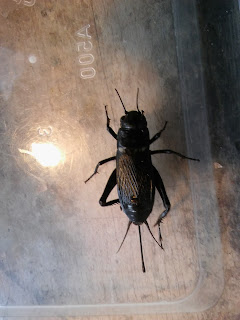The habitat is made out of a plastic shoebox, with bran to layer the ground (which you can purchase cheaply at most pet stores), a tub with damp play sand in, for the Crickets to lay eggs in (So far I've got about 1000 eggs in less than 3 weeks!), and a few sticks and leaves propped up around the habitat for them to get to the higher places, such as the tub of sand. Also, they have a toilet roll and some egg cartons for them to hide in (That's why you can't see many Crickets in the picture right now) Here's a picture of the Black Cricket Habitat.
 |
| Black Cricket Habitat Photo by Alex Sidney |
Now I'll show you how to separate Male Crickets from Female Crickets. The Female (Shown below), is usually very dark brown, or black in colour, and her wings are not very visible. Also, Females do not sing, or chirp. You'll notice a long black sword-like stinger. This is an ovipositor, for laying eggs, ad is completely harmless to us. The Females are usually slightly bigger than the Males, although this can vary depending on the species. The Males usually have dark brown bodies and light brown wings, and chirp very loudly to attract Females. They don't have an ovipositor like the Females, but they have two short Cerci at their rears, which females also have. The Males are slightly smaller than the Females, usually.
 |
| Female Black Cricket Photo by Alex Sidney |
 |
| Male Black Cricket Photo by Alex Sidney |
The Crickets are Omnivores, so they will eat meat and plant matter. My Crickets seem to like Moths, small Butterflies, Mealworms, Cucumber, Lettuce, Bran, Apple, Carrot, and much more.
A Cricket's average lifespan is 7-8 weeks, but only 2-3 weeks as an adult. In that time, they can lay up to 2000 eggs each!
No comments:
Post a Comment